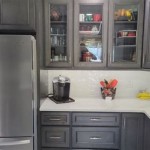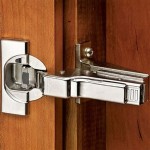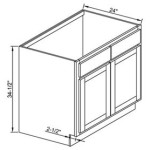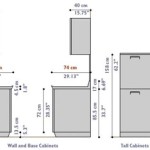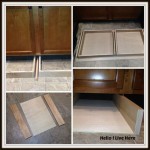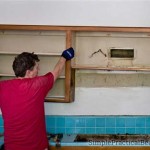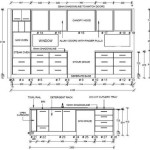What Tools Are Needed To Install Kitchen Cabinets and Countertops
Installing kitchen cabinets and countertops requires a combination of tools for accurate measurement, precise cutting, secure fastening, and proper finishing. Having the right tools on hand ensures efficient installation and professional-looking results. This article outlines the essential tools needed for this project.
Measurement and Marking: Accurate measurement is paramount for a successful kitchen renovation. Essential tools include a tape measure for determining lengths, widths, and heights. A level, preferably a 4-foot carpenter's level, ensures cabinets are plumb and countertops are level. A combination square helps mark accurate 90-degree angles and assists in making straight cuts. A marking pencil or scribe is needed to transfer measurements and cutting lines onto materials. A stud finder locates wall studs for secure cabinet mounting.
Cutting: Different materials require specialized cutting tools. For cutting wood, plywood, and cabinet backing, a circular saw offers versatility and power. A jigsaw is essential for making curved cuts and intricate notches. A miter saw provides precise angle cuts for trim and molding. A utility knife is useful for scoring and cutting drywall or other thin materials. When working with countertops, specialized tools are needed depending on the material. For laminate countertops, a laminate trimmer creates clean, flush edges. For solid surface or stone countertops, an angle grinder equipped with a diamond blade is necessary for cutting and shaping.
Fastening: Securing cabinets and countertops requires a range of fastening tools. A cordless drill is essential for driving screws and drilling pilot holes. A drill bit set with various sizes accommodates different screw sizes and materials. An impact driver provides extra torque for driving long screws and lag bolts, especially helpful when installing cabinets. A hammer is useful for tapping shims into place and driving nails. A nail gun, specifically a finish nailer, can speed up the installation process and provide a cleaner finish, especially for trim work.
Clamping and Supporting: Clamps are invaluable for holding materials together during assembly and gluing. Bar clamps are useful for larger cabinet sections, while C-clamps or quick-release clamps are suitable for smaller pieces. Cabinet jacks provide temporary support for wall cabinets during installation, allowing for adjustments before final fastening. Shims are essential for leveling cabinets and countertops, filling gaps and ensuring even surfaces.
Safety Equipment: Safety is paramount during any home improvement project. Safety glasses protect eyes from dust, debris, and flying particles. A dust mask or respirator prevents inhalation of dust, especially when cutting wood or working with stone countertops. Hearing protection is recommended when using power tools like circular saws and angle grinders. Work gloves protect hands from splinters, sharp edges, and potential injuries.
Miscellaneous Tools: Several other tools contribute to a smooth installation process. A pry bar is helpful for removing existing cabinets and countertops. A putty knife assists in applying and smoothing fillers and adhesives. A caulk gun applies sealant around countertops and sinks to prevent water damage. A sanding block or power sander smooths surfaces and prepares them for finishing. A utility knife with a sharp blade is indispensable for various cutting tasks. A multi-bit screwdriver with interchangeable heads handles different screw types.
Countertop-Specific Tools: In addition to the general tools mentioned above, certain tools are specifically required for countertop installation. A router with a specific bit is used to create the edge profile on laminate countertops. A belt sander or orbital sander can be used to smooth and refine the edges of solid surface countertops. Specialized polishing pads and compounds are required for achieving a high-gloss finish on some countertop materials. For undermount sinks, a hole saw kit allows for precise cutting of the sink opening.
Tool Organization and Preparation: Having the necessary tools is only part of the equation. Proper organization and preparation are crucial for an efficient installation. Before starting the project, ensure all tools are in good working condition. Sharpen dull blades, charge cordless tool batteries, and inspect power cords for damage. Organize tools logically in a toolbox or tool belt for easy access. Having a designated work area with adequate lighting and ventilation also contributes to a safer and more productive working environment. Finally, consult the manufacturer's instructions for the specific cabinets and countertops being installed, as they may recommend additional specialized tools or techniques.
Material Handling: Moving and handling large and heavy items like cabinets and countertops can be challenging and potentially dangerous. Enlist the help of another person when lifting and positioning these items. Use proper lifting techniques to avoid back injuries. A hand truck or dolly can assist in moving heavy cabinets and countertops across the floor. Support long countertop sections with sturdy sawhorses or other supports to prevent breakage during cutting and installation.

Cabinet Installation Kitchen Rta Cabinets Orange County Pre Made Whole Quartz Countertop Slab Prefab Granite

How To Install Kitchen Cabinets Diy Family Handyman

How To Install A Countertop Diy Family Handyman

How To Install Upper Cabinets Like A Pro Cabinetselect Com

20 Essential Cabinet Installation Tools That Make The Job Easy Electronicshub

How To Install Kitchen Cabinets And Remove Them Remodel Pt 1 Crafted Work

How To Install Laminate Countertops Yourself Dumpsters Com

How To Install Kitchen Cabinets

How To Remove Kitchen Cabinets Budget Dumpster

How To Install Countertops Expert Advice Rsk Marble Granite
Related Posts

